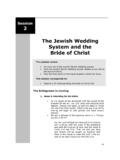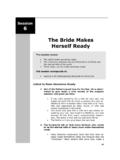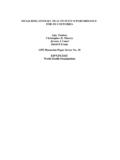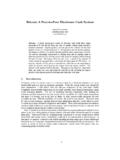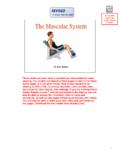Transcription of The Jewish Wedding System and the Bride of Christ
1 Session 2. The Jewish Wedding System and the Bride of Christ This session covers: An overview of the ancient Jewish Wedding System How the ancient Jewish Wedding System relates to our call as the Bride of Christ How the Holy Spirit is moving to prepare a Bride for Jesus This session corresponds to: Session 2 of Understanding the Bride of Christ CDs The Bridegroom Is Coming 1. Jesus is returning for His Bride . As the shout of the archangel and the sound of the trumpet fill the air, the Lord Jesus will descend from heaven. Graves will open up and the dead in Christ will rise from their tombs. Others who are alive at His coming will begin to defy gravity and head toward heaven. We get a glimpse of this glorious scene in 1 Thessa- lonians 4:16-17: For the Lord Himself will descend from heaven with a shout, with the voice of the archangel and with the trumpet of God, and the dead in Christ will rise first.
2 Then we who are alive and remain will be caught up together with them in the clouds to meet the Lord in the air, and so we shall always be with the Lord. 17. 18 Understanding the Bride of Christ Most likely, the parable of the ten virgins reveals the meaning of this shout and accompanying trumpet blast. It reads: But at midnight there was a shout, Behold, the bridegroom! Come out to meet him' (Matt. 25:6). Jesus is coming back to judge the nations. He is returning to establish His kingdom and to rule the earth. But He is also coming back as a Bridegroom for a Bride . The Bible reveals that Jesus' second coming will be simi- lar to ancient Jewish Wedding customs. Ancient Jewish Wedding Customs 1. The ancient Jewish Wedding System paints a beautiful picture of the coming Wedding between the Lord Jesus Christ and His Bride . According to Jewish Wedding customs at the time of Jesus' earthly ministry, the bridegroom came at a day and hour that his Bride did not know.
3 As he came, the friend of the bridegroom went before him and shouted, Behold, the bridegroom comes.. This shout would be accompanied by the blowing of a shofar a trum- pet made from a ram's horn. As the shout was heard, the bridegroom would get his Bride and take her back to his father's house, where the ceremony and celebration would take place. These customs sound a lot like Jesus' description of His second coming from the parable of the ten virgins (Matt. 25:1-13). To really understand the Lord's second coming and our calling as the Bride of Christ , let's look back in history to see the Jewish Wedding customs during the time of Jesus' earthly ministry. Five customs comprise the traditional Jewish Wedding System . These are: 1. The arrangement of marriage 2. The betrothal ceremony 3. The preparation period between the betrothal and the Wedding 4. The Wedding ceremony 5. The Wedding feast 2. The arrangement of marriage was the first custom of the ancient Jewish Wedding System .
4 The arrangement, called the Shiddukhin, was the first step in the process and refers to the arrangements that were made prior to the legal betrothal. 1. The Jewish Wedding System and the Bride of Christ 19. The arrangement was the time of matchmaking, often decided upon between the father of the groom and the father of the Bride . Often, the couple did not know each other before the arrangement. In some cases, they would not have even seen each other before the betrothal ceremony. 2. Though this was the case, the Bride -to-be was normally required to approve the marriage before the families agreed to a betrothal cere- mony. 3. Once the selection had been made, the parents prepared the ketubah. The ketubah was normally a written contract that depicted the terms and conditions of the marriage arrangement, the price to be paid by the groom, the responsibilities and obligations of both parties, and the dowry to be offered by the 3.
5 The betrothal ceremony was the second custom of the ancient Jewish Wedding System . Once the arrangement was made and the ketubah agreed to by both parties, the couple would move on to the betrothal (eyrusin) cere- mony. To prepare for this, the Bride and groom would take part separately in a ritual immersion in water, which symbolized a spiritual cleansing. 5. The ceremony would include vows promising to be married, the ex- change of rings or something else of value, and the sealing of the agreement by sharing a cup of wine. 6. After this ceremony, the couple was legally married even though they did not live in the same house or have sexual relations. Instead, the groom and Bride maintained separate dwelling places, both remaining under their fathers' Because a betrothed couple was legally married, a separation or part- ing of ways for any reason would require a legal divorce. The Jews used to refer to the act of betrothal as taking a wife by us- ing a form of a Hebrew word that meant purchase.
6 The betrothal ceremony was considered an act of purchasing or acquiring a wife for the purpose of marriage. 8. The betrothal ceremony would end with a feast to celebrate the occa- sion, and following the feast, each party would return to his or her parent's 4. The preparation period was the third custom of the ancient Jewish Wedding System . During the betrothal period, the groom remained at his father's home and prepared a place for the two to live. This was normally done by adding a room to his father's house. While the groom was busy building, the Bride was preparing herself for the upcoming Wedding . This usually involved three things. First, the Bride was observed for her purity. This custom required at least a full nine months to pass in order to ensure that the Bride was not pregnant and to attempt to assure that she was a virgin. 10. 20 Understanding the Bride of Christ Second, the Bride consecrated herself.
7 She examined everything in her life and changed whatever was necessary in order to be ready for the holy covenant of marriage. In fact, Jewish leaders began to use 11. the term mekadesh (consecrated) for the act of betrothal. During the betrothal ceremony, the groom would often say to his Bride that you are mekudeshet (consecrated) unto me. Therefore, the Bride made 12. sure that she was totally set apart from all other relationships and ac- tivities and that she was completely separated for her groom. Third, the Bride made her own Wedding garments. Ancient Jewish women did not have the luxury of going to the nearest bridal shop and purchasing a premade dress. They had to spend hours and hours making their Wedding garments and adorning them with the special touches to make them beautiful. 13. 5. The Wedding ceremony was the fourth custom of the ancient Jewish Wedding System . Toward the end of the yearlong betrothal period, the Bride waited with great expectancy for the groom to come and for the ceremony to take place.
8 Even late in the evening, the Bride and her Wedding party would keep their oil lamps burning in case it was time for the Wedding to take place. The day of the ceremony was a surprise to both the groom and the Bride . When the bridegroom was asked the date of the Wedding , he 14. could only say something like, No man knows except my father. 15. When the time was right, the groom's father would issue the approval for the ceremony to begin. The groom and his Wedding party would leave the groom's house to go get his Bride . The friends of the Bride - groom would shout, Behold, the bridegroom comes! and then they would blow the shofar. The groomsmen would lead the Wedding party through the streets and bring the Bride back to the groom's home where the Wedding canopy or huppah awaited. The Wedding ceremony, or the nissuin, was performed under the hup- pah. The vows made during the betrothal ceremony were completed in the marriage ceremony.
9 The ceremony was once again sealed with a cup of wine to indicate the great joy that would accompany the festive celebration. After the ceremony, the couple consummated the mar- riage with sexual relations and lived together as husband and wife from that point 6. The Wedding feast was the fifth custom of the ancient Jewish wed- ding System . The Wedding feast was the highlight of the Wedding ceremony. It was much more extensive than what Westerners are accustomed to today. It consisted of seven full days of food, music, dance, and celebra- The primary purpose of the Wedding feast was to honor the groom. All of the guests were expected to compose poems or sing songs to the groom. The Jewish Wedding System and the Bride of Christ 21. Now that the blessed bridegroom had received a wife, he was sup- posed to display her beauty and grace to all who were present. To honor the groom, the Bride would put on her beautiful Wedding garments that she made during her year of preparation and would dis- play her beauty to the bridegroom's friends, and the attendees, in re- turn, would show her respect and admiration.
10 18. Following the Wedding feast, the bridegroom and the Bride would live together as husband and wife for the remainder of their lives. The Jewish Wedding System and the Bride of Christ The parallels between the ancient Jewish Wedding System and the Wedding between Jesus and His Bride are amazing. 1. Jesus' first coming was like the arrangement of marriage in the Jew- ish Wedding System . If you are a born-again believer, you are the recipient of an arranged marriage. Your heavenly Father so loved the world that He arranged a marriage between His Son and mankind. He sent Jesus to explain the terms and conditions of a life with Him. He offered a heavenly ketubah, or marriage contract, to describe what marriage to Him would include. Jesus, the Bridegroom, gave His life on the cross to purchase His Bride . The heavenly Father also sent His matchmaker, the Holy Spirit, to in- vite us to become the Bride of Christ by saying yes to His invitation.
